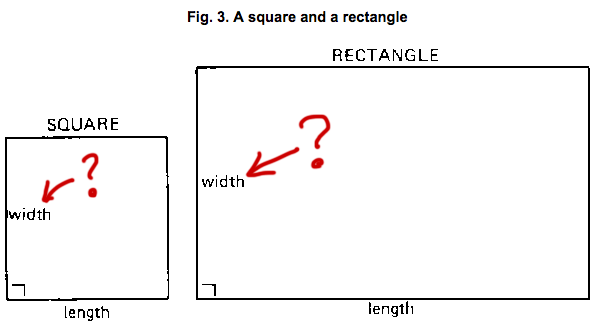What exactly is “width” in geometry?
I had never thought I would ever wonder what “width” is until my 12-year old daughter came home one day and told me that her math teachers (not just one but two) told her that “width” in geometry is the vertical side of a rectangle. That to me was like saying up is down and down is up. How could this be?
It turns out that her teachers are not alone. Take a look at this page I came across while Googling on the topic. It says:
In the case of a square or a rectangle, the expression length (1) is commonly used instead of base and width (w) instead of height. In the case of a circle the expression diametre (d) is used.

“Width instead of height” is very much like saying up is down. Where did this come from?
And, what is even more disconcerting is that the teachers are not aware of this ambiguous nature of “width.” Two other teachers told me that width is always the horizontal side, and another told me that she has heard others call the vertical side “width.” So, apparently, each is teaching their students in an authoritative manner their own definition of “width.” If a 12-year old is told by her math teacher that “width” in geometry refers to the vertical side, why should she doubt it? Unless, of course, she was also told that “width” can be vertical or horizontal (i.e. direction neutral, like “length”). But that is apparently not what is happening at school in New York City.
If we teach our kids that a triangle has three sides, we don’t want them thinking that the definition of “triangle” could be flexible as if it could have four or five sides. If the definition of “width” is not universal, they need to know that. Here is a case in point. The following question was in 2016 Common Core Math Test for Grade 6.
“A carpenter built three bookcases, A, B, and C, to stand next to each other along a wall. The total length of the wall is 456 centimeters. The carpenter will build two more bookcases, D and E, along the same wall. These two bookcases will have equal widths. The widths of bookcases A, B, and C are shown in the table blow.”
Now, if you were taught that in geometry, “width” means the vertical side and “length” means the horizontal side, you would have to be confused reading this question. The correct response would be, “But why should the ‘widths’ of the bookcases have anything to do with the ‘length’ of the wall in fitting the bookcases?”
My daughter tried to figure this out by drawing a bunch of bookshelves with different heights, and eventually gave up because the question made no sense to her.
In Merriam-Webster, the word “width” has no ambiguity: “the horizontal measurement taken at right angles to the length.” After all, the word “height” has no ambiguity, so why should we think “width” would?
But looking at the Oxford dictionary gives us a slightly different answer: “The measurement or extent of something from side to side; the lesser of two or the least of three dimensions of a body.”
In other words, in a rectangle, “the lesser of the two” sides would be called “width” regardless of the orientation. So, it appears that this is an American-versus-British issue, or is it? (Note the spelling of “diametre” on the page from fao.org quoted above.)








The geometric definition of width is not really up for interpretation. From Wolfram Mathworld; "The width of a box is the horizontal distance from side to side" -- http://mathworld.wolfram.com/Width.html
Additionally, hundreds of millions of websites and every computer, phone and tablet capable of rendering a web page has agreed that width is the horizontal measure of a box, height refers to the vertical.
How is this nonsense possible?
tall not wide May-08-2017
14 votes Permalink Report Abuse
I just thought of one scenario where "width" is indeed used independently of the orientation: a carpet.
I think most people would call the shorter side "width" and the longer side "length" when describing the dimensions of a carpet regardless of where they are standing in relation to it. And, if they were to draw it on a piece of paper, they are more likely to draw it horizontally and still call the vertical side "width." This is because we write horizontally; drawing the carpet vertically on a sheet of paper would take up too much space.
So, any two-dimensional shape lying flat on the ground would use the convention where "width" is orientation-neutral. This may include a shape of land, pool, and road. It, therefore, makes sense that Food and Agriculture Organization of the United Nations (the quote in my original post) would use "width" independently of the orientation. In fact, I can't think of another word that we could use instead of "width." In other languages, there may be an orientation-neutral word that is paired with "length" which simply means "the shorter side." In English, there isn't one.
This may be the source of confusion.
The word "height" has no ambiguities because it's not possible for us to change our standing positions in order to change the orientation. (We would have to be able to defy gravity and stand on a wall.) In contrast, with a shape lying flat on the ground, we can easily change the orientation without moving the object, hence the confusion/ambiguity.
Dyske May-08-2017
11 votes Permalink Report Abuse
These are NCTM standards https://illuminations.nctm.org/Lesson.aspx?id=1845
I understand your concept, but to help your daughter succeed in the subject, just explain to her that the width of the bookcase is a practical reference for carpentry. For the geometry of it, the bookcase can be turned on its side to plan a technical measurement.
AnthonyR Jun-25-2017
4 votes Permalink Report Abuse
As with many words, the meaning of "width" depends on the context. I would say your answer is given by the Oxford's definition. If you notice, two different definitions are given, the first assuming the object is upright and with width meaning the side-to-side distance. The other definition is orientation independent, and in my opinion better because of it, and it simply states that for a 2 or 3 dimensional rectangular (-prism), he width is the shortest dimension's distance. This is a common challenge when you use words that have a colloquial meaning and a technical meaning. Other examples are the word acceleration, in physics slowing down means you are accelerating, in fact, your speed may not change at all yet you may still have an acceleration; in a colloquial environment, acceleration is associated with increasing one's speed only. A person's weight prompts different answers from different people, in general you'd expect an answer in pounds or kilograms, a physicist would probably say, "assuming it's on Earth, the weight is", followed by a number of Newtons.
The way I address it with my own children is to explain to them the more nuanced definition, trying not to openly undermine the teacher but rather expanding on what they were taught on the first place, when it is possible. My approach has always been explain to them as if they were scientists, and build up your answers until they seem to have enough or are not engaged. Discussions about the color of the sky, or the meaning of pi, with 4 year old children can be wonderful experiences for you and for them and allows them to question what they learn at school and expand on it.
Jorge Millan O Aug-04-2017
5 votes Permalink Report Abuse
Get a protractor and cut a bowling ball in half using a whiteboard marker. Then find 5 angles, two being in the exact same spot, after that is done you should realize there isn't a point to doing this.
connor Dec-12-2017
3 votes Permalink Report Abuse
Another illustration of the confusion is with bathroom sinks. Some online vendor of sinks will call the front-to-back distance the width; others, the left-to-right distance.
Phineas Jan-04-2018
2 votes Permalink Report Abuse
It is a shame. There's an endless supply of self-satisfied fools in charge of education, and in charge of testing that education. The goal appears to be to ask the question is the minimum number of words, as though "question space" on the printed page is something of supreme importance.
Rich Byrne Jan-07-2018
2 votes Permalink Report Abuse
If you are talking about a rectangle, which is usually represented in a sort of landscape orientation, and describing the dimensions as width and length, it is only natural to use "length" to reference the longer side. It would be odd to have the shorter side described as length. This seems to me to be simply a convention in geometry. It doesn't have to make sense with English, Merriam-Webster or any other source. It just needs to be internally consistent within Geometry and to make sense with the terms that are chosen for the shapes. True, you can make a case that "width" doesn't appear to be used well here, but if it is paired with "length," I don't see a way around this outcome. Be comforted by the fact that this is walled off from the rest of the language and should cause no one any serious difficulty.
You might make a similar a similar complaint in graphing with the term "rise over run." Run is a bit ambiguous, as is width. But there is no mistaking what rise is on a graph.
Perhaps the confusion here CAN bleed into the "real" world. There are times I have been confused about a product description, for example, when two dimensions are simply described as a number by another number, such as 100 mm x 100 mm. Obviously a square, but if the numbers aren't equal, you might have to surmise what side the longer number refers to. I am sure there have been other instances. What I find is that the confusion is only me. The people in that business use these numbers all the time and there is no question about them. It helps me to get someone on the phone and discuss the product so I can become familiar with their jargon.
kellyjohnj Jan-30-2018
3 votes Permalink Report Abuse
Hello, Math tutor here. I grew up in the British system of education however I now live in the U.S. and tutor Math at an Elementary School. I was horrified when I saw a teacher labeling the shorter side of a rectangle as the length and the longer side as the width. I learned exactly what the Oxford Dictionary states: width is the lesser of 2 sides. When I pointed it out to the teacher he proceeded to argue with me and tell me I was wrong so I guess you’re right. It’s an American vs. British issue.
user111068 Oct-18-2021
0 vote Permalink Report Abuse
Can a diagonal line (still) be straight, rather than wobbly ?
user112115 Aug-30-2023
0 vote Permalink Report Abuse
I meant, for instance, that some towers are not straight, yet they can be as straight as an arrow in contrast to being curved. Therefore; can a diagonal line (still) be (perfectly) straight, in the sense of not curved / wobbly. Although I assume that even a wobbly line can be called straight if it does not deviate too much from a certain direction.
user112115 Oct-18-2023
0 vote Permalink Report Abuse